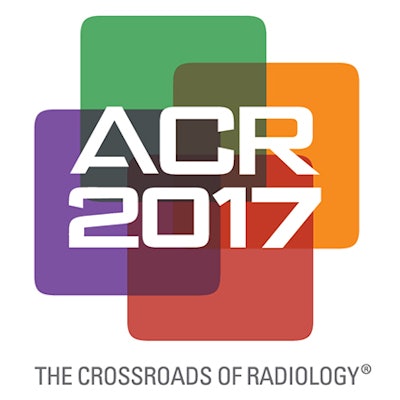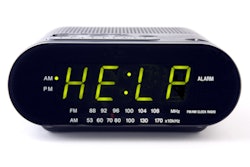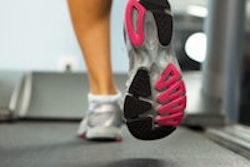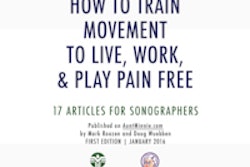
WASHINGTON, DC - If sitting is the new smoking, then radiologists have a bad habit to kick. Fortunately, teaching them ways to be more active can have a positive effect, according to a presentation at this week's American College of Radiology (ACR) annual meeting.
Researchers from Rutgers Robert Wood Johnson Medical School reported encouraging results from their new nine-week health and wellness curriculum that teaches their colleagues simple ways to become more active. Some 75% of radiologists and residents who participated in the program rated it as helpful to extremely helpful in raising their awareness of the risks of prolonged inactivity, adding that the course inspired them to make changes in their daily routines.
"Despite our awareness of the risks of sedentary behavior, many find it difficult to incorporate physical activity into the day due to our perception of lack of time. This is more apparent now with an increased volume of cases," said lead author and radiology resident Dr. Halley Park. "We were determined to develop a health and wellness curriculum aimed at educating our radiologists to adopt and continue healthy behavior at work in order to improve their quality of life."
Sedentary behavior
There is no doubt that radiologists participate in less physical activity at work than other medical specialties, which places them at an increased risk of sedentary behavior. Radiologists also engage in what can seem like endless uninterrupted hours of reading due to an increased volume of cases, pressure for fast reporting, and an emphasis on relative value units (RVUs) for reimbursement.
Sedentary lifestyles contribute to a greater risk of adverse cardiac health, diabetes, and myocardial infarction. Such a lack of activity has also been linked to poor psychological health and a negative perception of one's quality of life, which can lead to burnout, fatigue, and decreased concentration.
"Another finding I thought was particularly troublesome and shocking is that in the most recent research, the risk that is associated with sedentary behavior in the workplace is not decreased by efforts such as exercise outside of the workplace," Park said. "In other words, we can no longer think we are safe by exercising for an hour outside of work, if we remain sedentary during the workday. The risk that comes with that sedentary lifestyle at work is not abated by our efforts outside of work."
On the other hand, physical activity both at work and outside of work is associated with decreased stress levels and can boost our self-perception of well-being, encourage social interaction with other physicians, and increase productivity and the power of learning, she said.
Activity survey
Park and colleagues sent an anonymized survey to fellow radiologists and residents asking them to describe their amount and type of physical activity at work and outside of the office. Among the 105 responses, 73% said they were sedentary or very sedentary at work, while 24% rated their activity as neutral and 4% were active or very active.
By far, the main deterrents to onsite activity cited by the respondents were responsibility for work and lack of time (71%). In addition, 50% of those polled said their inactivity at work had a negative or very negative effect on their mental health.
"That corresponds strongly to the research finding that simply staying active outside of work is not enough time for the negative effects that come with being sedentary in the workplace," Park said.
After seeing the survey results, the researchers developed a nine-week curriculum that used email to distribute information on various topics. The communiqués highlighted stretching exercises radiologists and residents could do while working, as well as photos of how to improve posture at the desk or by standing while reading. The weekly advice also addressed ergonomics and desk structure and provided suggestions on health, wellness, and activity apps such as Fitbit and Strava.
"We also focused on making the curriculum as visual as possible, since we felt that most radiologists are visual learners," Park said. "Essentially, our goal was to provide information with tips and ideas that were realistic and easy to implement."
They also created a "journal club" for residents to pass along scientific papers related to health, such as how to decrease repetitive stress injuries and basic ways to increase activity during the workday. One underlying goal of the journal club was to make radiologists more aware of the need to adopt healthy habits at work earlier in their careers, Park said.
Changing lifestyles
At the end of the health and wellness curriculum, the researchers sent a follow-up survey, receiving a 45% response rate. Overall, 75% of the respondents rated the curriculum as helpful to extremely helpful, while 78% said the course inspired them to make changes and incorporate healthy behavior into the workplace. In addition, 85% of those polled wanted the health and wellness program to continue.
As for the information that was most helpful, the respondents cited stretching exercises, desk posture, ergonomics, and eye exercises.
"While creating this curriculum, we thought that awareness is the No. 1 step to making changes," Park said. "It is our intention to continue this project, especially since we feel this issue of health and wellness will always be important in our careers."
In the near future, the researchers plan to cover topics using more images and short videos. Many survey respondents also requested updates through quarterly newsletters to keep up with current best practices to maintain healthy behavior.



















